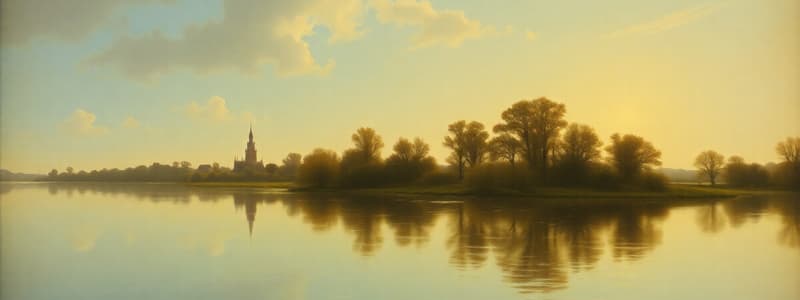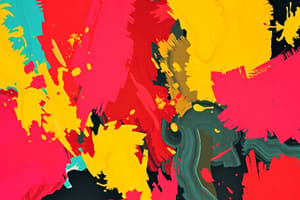Podcast
Questions and Answers
Which photographic technique uses magnesium ash as a primary component?
Which photographic technique uses magnesium ash as a primary component?
- Camera lucida
- Magic lantern (correct)
- Silhouette
- Daguerreotype
What does the term 'latent image' refer to in photography?
What does the term 'latent image' refer to in photography?
- An unprocessed image recorded on a photosensitive surface (correct)
- An image captured using instantaneous photography
- An image that appears on a print after development
- An image visible immediately after exposure
Which of the following prints is created using a process that involves a salt solution?
Which of the following prints is created using a process that involves a salt solution?
- Cyanotype
- Gum printing
- Collodion (wet-plate)
- Salt print (correct)
What type of photographs does the term 'Pictorialism' describe?
What type of photographs does the term 'Pictorialism' describe?
Which print is known for its unique ability to create a three-dimensional effect?
Which print is known for its unique ability to create a three-dimensional effect?
What characterizes the gelatino-silver print process in photography?
What characterizes the gelatino-silver print process in photography?
What distinguishes a Calotype from a Daguerreotype in photographic processes?
What distinguishes a Calotype from a Daguerreotype in photographic processes?
Flashcards
Daguerreotype
Daguerreotype
A photographic process using a metal plate coated with silver iodide, exposed to light and then developed with mercury vapor, resulting in a positive image.
Calotype
Calotype
A photographic process involving a paper negative, producing a positive print on another sheet of paper using a contact printing method.
Collodion (wet-plate)
Collodion (wet-plate)
An early photographic process using a glass plate coated with a light-sensitive collodion solution. It required the plate to be exposed and developed immediately.
Albumen paper
Albumen paper
Signup and view all the flashcards
Gelatin silver print
Gelatin silver print
Signup and view all the flashcards
Photogravure
Photogravure
Signup and view all the flashcards
Baryta
Baryta
Signup and view all the flashcards
Study Notes
Photography Processes
- Pantograph: A process for making copies of a drawing or design
- Physionotrace: A process to obtain a photographic image of a human physique
- Silhouette: A photographic technique to capture the outline of a subject
- Camera lucida: A device to sketch an image directly from a viewfinder
- Camera obscura: A darkened room with a small hole to project an image onto a surface
- Sun printing: A process for making photographic prints using sunlight
- Heliography: A process using sunlight to produce images on a light-sensitive surface
- Daguerreotype: An early photographic process producing a single image on a silvered copper plate
- Calotype: An early photographic process using paper coated with light-sensitive chemicals
- Collodion (wet-plate): A photographic process using a collodion-coated glass plate
- Albumen paper: A photographic paper coated with albumen (egg white) to support the light-sensitive materials.
- Combination printing: A process producing both negative and positive photographic images
- Negative/positive/direct positive: A process that produces a negative image first and then a positive from the negative
- 3-part laminar structure of photographs: Photographic process resulting in 3 separate layers of an image.
- Latent image: An invisible image formed on a light-sensitive material during exposure
- Tintype: A photographic process using a thin sheet of metal, often tin, as a support for the image
- Ambrotype: An early photographic process with an image on a glass plate that is backed with a dark material
- Cartes de visites: Small photographic portraits printed on visiting cards
- Cyanotype: A photographic print using a cyan-based chemical
- Stereoscopy/stereograph: A process to create a three-dimensional image from two slightly different viewpoints
- Dry plate: A process to produce photographic images making use of plates not needing a wet process.
- Instantaneous photography: A process to capture an image quickly with rapid action, resulting in a finished image quickly.
- Snapshot: An instantly captured image via a camera, most famously associated with the Kodak brand
- Kodak: A significant brand known for cameras and photographic products
- Magic lantern: An early projector for displaying images
- Magnesium flash: A flash technique using a magnesium powder device for a quick photographic exposure result.
- Pictorialism: A style focusing on artistic quality in photography.
- Salt print: A printing technique using salt and light-sensitive materials
- Platinum print: An advanced printing process using platinum as a material.
- Gelatin silver print: A printing process using gelatin-silver as material
- POP (Printed out print): A print process producing a print on an image
- DOP (Developed out print): Images created from a negative undergoing processing to create a positive image.
- Baryta: A type of photographic paper
- Half tone: Process that converts continuous-tone images into halftones.
- Straight photography: A style that is authentic to the image seen
- Pre-visualisation: A style of photography that is planned ahead of time prior to image capture.
- Photogravure: A print reproduced by etching into a metal plate that creates the image
- Gum printing: A slow, detailed process of imaging on paper coated with gum, creating a print.
- Celluloid/nitrate film: A photographic film made of celluloid or nitrate.
- Photomechanical reproduction: Copying images using mechanical techniques
- Photo-magazine: A magazine dedicated to photography.
- Autochrome: A color photographic process
- Kodachrome: A popular color photographic film by Kodak.
Studying That Suits You
Use AI to generate personalized quizzes and flashcards to suit your learning preferences.




